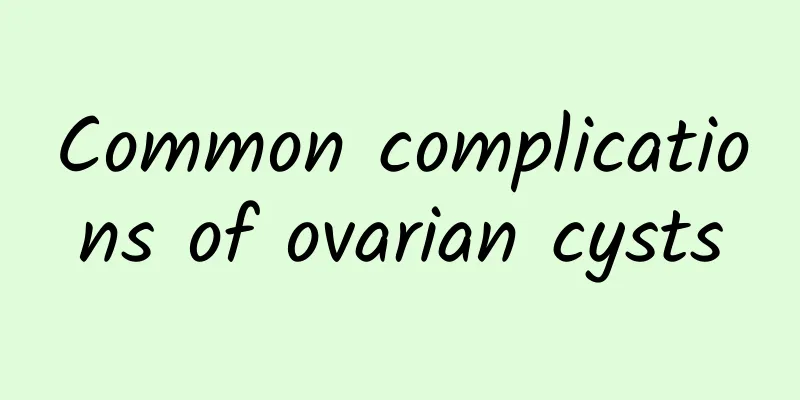Common complications of ovarian cysts

|
Ovarian cysts are a serious disease that endangers women's health. If not treated in time, complications of ovarian cysts will occur, further harming female friends. What are the common complications of ovarian cysts ? Let's talk about the common complications of ovarian cysts. Common complications of ovarian cysts include: 1. Ovarian tumor It is the most common complication of ovarian cysts. Although the ovaries are small in size, they are the organs where tumors are most likely to occur; the number of tumor types is also the highest among all organs in the body. Ovarian cysts are common gynecological diseases. They can occur at any age, but are more common in women of childbearing age. Since the ovaries are located in the pelvic cavity, they cannot be directly observed, and there are no symptoms in the early stages. There is a lack of good early diagnosis and differentiation methods. Once a malignant tumor is discovered, it is often an advanced lesion. Therefore, to date, the 5-year survival rate of ovarian cancer is still only 25%-30%, making it the most threatening disease among gynecological tumors. 2. Tumor pedicle torsion About 10% of ovarian cysts are torsion. The conditions for ovarian tumor pedicle torsion are that the pedicle is long and the tumor is as big as a fist or a fetal head, there is no adhesion to the surrounding tissue, and the tumor is easy to move in the abdominal cavity. It is also a common complication of ovarian cysts. Cystic teratomas, mucinous and serous cystadenomas are most likely to have pedicle torsion. The pedicles of these tumors are generally long and the center of gravity is biased to one side. The tumor is easily rotated by intestinal peristalsis or changes in body position. 3. Rupture This type of complication of ovarian cyst refers to the cyst rupture or squeeze, and its contents overflow into the abdominal cavity; the latter refers to the cyst contents eroding the cyst wall and entering the abdominal cavity, such as the papillary protrusions of serous cystadenomas or cancers penetrating the tumor wall. The rupture rate of ovarian tumors is about 3%, and malignant teratomas are most likely to rupture. Spontaneous rupture is more common. Due to rapid growth, the local blood supply of the cyst wall is insufficient, and the incremental cystic fluid breaks out from the weak part of the cyst wall and overflows into the abdominal cavity. Different tumor contents can cause different consequences in the abdominal cavity, and in the process of forming these conditions, it can cause membranous inflammation, intestinal adhesions, and even intestinal obstruction. This is also one of the common complications of ovarian cysts. |
<<: Warning: Several common hazards of ovarian cysts
>>: Long-term sitting requires vigilance against the cause of adnexitis
Recommend
What can you eat to eliminate uterine fibroids? Uterine fibroids are most afraid of three kinds of fruits
What can you eat to eliminate uterine fibroids? U...
How to treat chronic Bartholinitis
Bartholinitis is one of the more common inflammat...
Why is cervical erosion difficult to cure? 11 root causes of cervical erosion
Many women suffer from cervical erosion, because ...
Effectively relieve dysmenorrhea from daily life
Dysmenorrhea is not unfamiliar to everyone. Perha...
Are cervical precancerous lesions serious hazards to patients?
What harm does cervical precancerous lesions do t...
What should I do if I have abnormal menstruation after taking birth control pills?
What should I do if I have abnormal menstruation ...
Can abortion be performed with medical treatment after incisional pregnancy? Let’s take a look
Incisional pregnancy, also known as cesarean scar...
The dangers of ovarian cyst rupture
Risks of ovarian cyst rupture: Speaking of ovaria...
The main causes of ectopic pregnancy
Among these gynecological diseases, the high inci...
The causes of mild cervical erosion are generally divided into the following points
Cervical erosion is a disease that many people ha...
Symptoms of PCOS
Polycystic ovary syndrome is an endocrine disease...
Beginners of stepping exercise start here
Start with barefoot steps Start “stepping” now. F...
What is the reason for frequent dysmenorrhea? Is frequent dysmenorrhea related to submucosal uterine fibroids?
Dysmenorrhea refers to lower abdominal or back pa...
How many types of hemostatic drugs are there for treating functional uterine bleeding?
Dysfunctional uterine bleeding is mainly manifest...
Symptoms of chocolate cyst
Chocolate cysts are very novel to many women. Eve...









